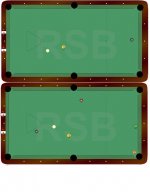Loun said:
I went looking for some "jumping lessons" but wasnt able to find anything on blackjacks page and since its 5am and i havent gone to bed I am useless right now trying to locate it elsewhere. Anyone have a link to a tutorial?
OK, since you asked for "jumping" tips, here goes it.
First, I'll tell you what jumping is NOT: Common misconceptions
1. Elevating the stick way high
2. Death grip on the stick
3. Pounding into the cue ball
Those 3 things will guarantee that you won't jump successfully.
So, now here's what Jumping IS:
1. Many jump newbs first try to elevate their stick too much. For starters, simply elevate the butt of the stick about 30 degrees.
2. Aim basically through the core center of the cue ball. Sometimes people tend to try to aim too low on the cue ball, even when they think they are hitting core center. So, as a correction, go ahead and aim about 3/4 of a tip above core center.
3. Grip lightly. Very important, when people start jumping, they tend to try to grip the stick too hard. Gripping too hard gives less beneficial jumping results, and increases the chances of damaging the table felt. Gripping lightly will allow the proper movements to occur.
For example, just to help you relax about tearing the felt do the following: Just lightly and comfortably grip the stick with thumb and index fingers and middle finger (overhand grip for this exercise). Now just flick the stick right at the table felt itself. You should see the stick just bounce right off the table without even coming close to ripping the felt. You should see some lines on the felt left from the chalk, but that's basically it. When you do this a few times, you'll see that you don't have to be quite so afraid of the felt.
Also note: if you do create a huge gash in the table, then I'm not liable for any information contained herein....

4. Flick it. The motion for jumping is not about powering the ball, but instead is to flick it. The motion is more like throwing a dart. You can feel it in the wrists.
Another ironic aspect of learning to jump, is that people tend to start off trying virtually the most difficult jump there is. Grab the cue ball, put it about 4 inches or less behind another ball, and try to jump clear over it. It can be done, but I'd bet virtually any amount of money that any new jumper will fail at that one.
Instead, start with an easy jump. Setup 3 object balls in a row all touching each other. This line of balls should be perpendicular to the line to the cue ball, which will be about 15 inches away. Remove the middle ball. Theoretically, it'd be possible to get the cue ball through there, but extremely unlikely. So, feel free to move 1 object ball about 1 millimeter or less closer to the other object ball. Now, you know it's impossible to get through without jumping.
When you succeed at jumping by that, then you can shrink and shrink the gap, until eventually you are able to jump over a full ball. By this time you will have also developed the proper feel for it.
5. Now that you have those basics down, just go ahead and attack it. After all this earlier discussion about grip lightly and flick it, people tend to learn the proper feel, but are also too timid. Now, you can attack it, and be more aggressive. Sort of like, really snapping a dart.
Also feel free to try the overhand grip for jumping as well. That will really feel as if you are throwing a dart. NOTE: even with overhand grip, you typically do not want to over elevate the butt of the stick. In most situations, would not recommend elevating the butt of the stick past 45 degrees.
The key to jump sticks is that they are lighter. Thus, the stick bounces away from the ball quicker, allowing for more spring from the cue ball as it recoils off the table slate and felt.
Detailed physics description coming shortly ... j/k.
